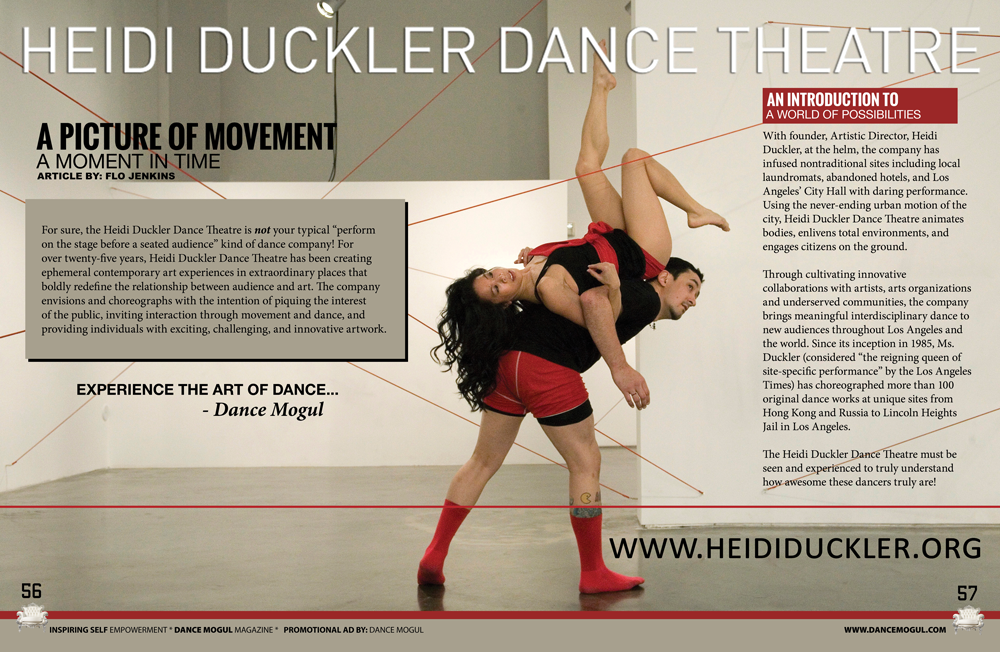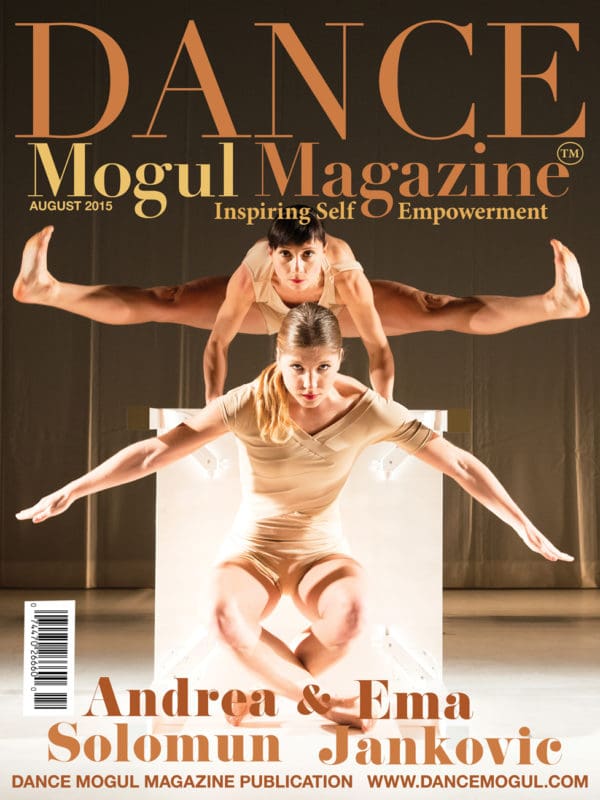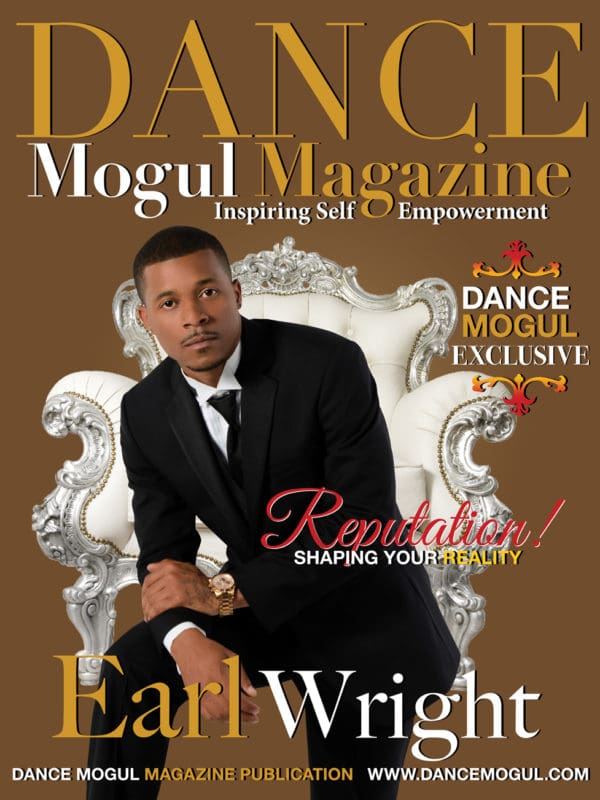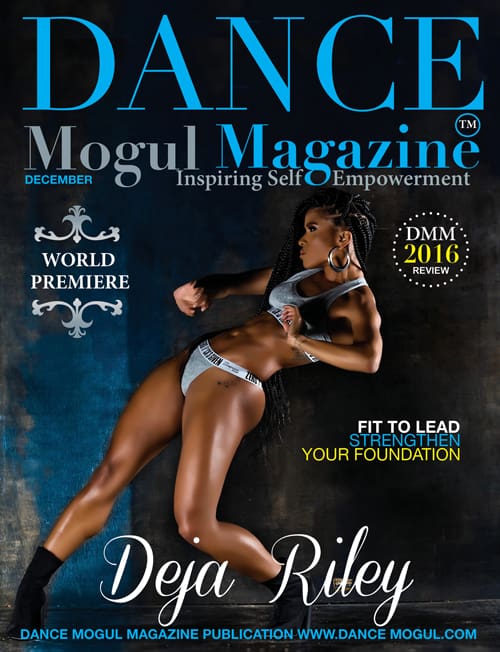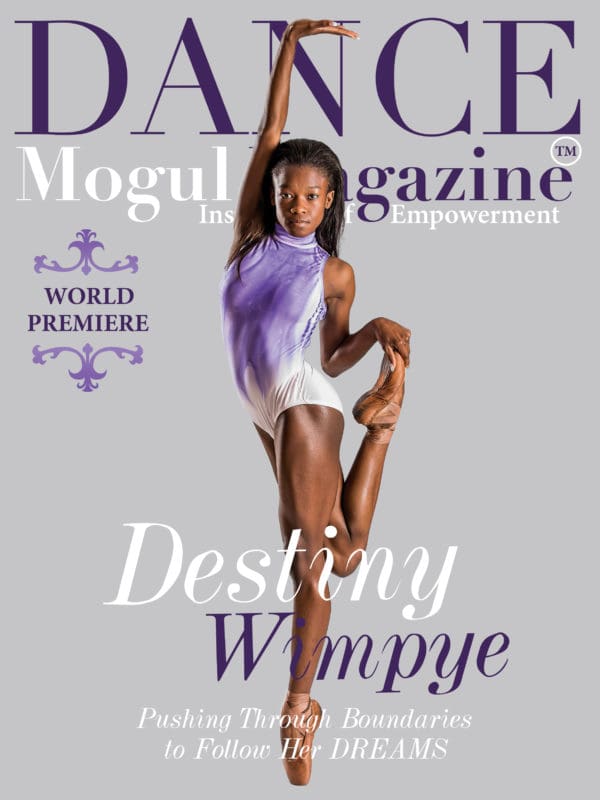Dance Mogul Magazine Exclusive…
Dance Mogul: Exclusive Interview by DMM Executive Editor, Flo Jenkins, with Heidi Duckler, Founder of The Heidi Duckler Dance Theatre
Heidi Duckler: For about 30 years, the Heidi Duckler Dance Theatre, under the leadership of Founder/Artistic Director, Heidi Duckler has been receiving awards for their artistry, but those awards seem not nearly as special as the rewards they receive from the audiences they’ve entertained and inspired through their very nontraditional dance pieces. Their productions are special events every dance lover should experience!
Dance Mogul: Your Mission Statement, to build communities through the performing arts, creating contemporary art experiences in nontraditional places and learning opportunities in diverse neighborhoods that redefine the relationship between audience and art through the cultivation of innovative partnerships… that’s quite a lofty and awesome goal. How did you arrive at that intent? Can you talk about that a bit?
Heidi Duckler: As a choreographer who has worked exclusively in nontraditional sites for nearly 30 years, I view location, history, and community as my creative partners. I consistently draw upon the conceptual complexity and identity of each location to drive the creation and implementation of my company’s professional performances and learning opportunities. Therefore, we inadvertently, yet strategically build communities with each project. From the community at the La Brea Coin-Op where neighborhood kids would gather during our rehearsals to the two weeks we spent teaching at Culver City Middle School, Heidi Duckler Dance Theatre is a creative network of dancers, designers, community partners, Board Members, audiences, and artists, all of whom are champions for the interdisciplinary, community-driven work. Our mission drives the company forward, thus the complexity reflects our multi-dimensional programming and vision.
Dance Mogul: Explain the concept of your dance theatre? How did you arrive at this particular non-traditional concept where your dancers are not on the usual stage performing to a seated audience?
Heidi Duckler: Our dance theatre is a performance on the streets and about the streets. The context and location are inseparable. The subject matter is closely aligned with geography, identity, and a relationship with an audience. As a choreographer, I have always been interested in how spatial orientation affects what we have to say. Changing relationships in space throughout an environment form the foundation of the work, so that our performances cannot be created in a situation where the audience is immobilized i.e. sitting still in a theater.
Dance Mogul: Who… or what in particular… was the biggest inspiration for you as a dancer/artist? And who or what was your greatest inspiration in creating your particular concept and this Dance Theatre?
Heidi Duckler: I am inspired by so much of life, and much of what I experience and contemplate filters into my work. I am inspired by reading, movies, fashion, cooking, traveling, and listening to stories from my friends, family, and co-workers. I enjoy participating in life, and my work reflects these personal journeys. Informed by my reaction to the complexity of place, my work incorporates ideas from architecture, literature, visual art, and music.
Dance Mogul: What have been the biggest challenges your company has faced, artistically—and what has been your major challenge, personally, as your company has developed over the years? The company will be celebrating its 30th year anniversary next year, and as exciting as that is, history (quite literally!) carries baggage and challenges including a storage unit of props, sets, and costumes that you never quite see the back wall of, digitizing hours of footage and hundreds of photographs, and modernizing internal systems and best practices. What does one do with a past partner that happens to be a Westinghouse refrigerator?
Heidi Duckler: Personally, a big challenge has been keeping up with our expansion as we create performances in different parts of the world. It is artistically challenging to make site work in sites unseen, partnering with new communities, and meeting artists with different histories from my own. It takes time and sensitivity to discover a collaborative environment to communicate and make the best possible work.
Dance Mogul: How is the Heidi Duckler Dance Theatre generally received by audiences, in that you’re not the traditional dance company? What was your reception like in the beginning, compared to how you are received today? How difficult was it explaining your concept and gaining the support you needed?
Heidi Duckler: Categories are always challenging to determine, and defining our company is difficult because we do not fall neatly into the traditional parameters of a specific style such as ballet, modern, or jazz. Some old fashioned panels underestimate our value, but in a large part, our audiences appreciate us (and of course, this appreciation is mutual!). Perhaps most frequently though, the cultural and thought leaders of a community not only understand but also share and celebrate the relevance of what we do with their constituents. Our work exists at the intersection of architecture, dance, and social justice, and community leaders frequently see the positive lasting effects of our work.
Dance Mogul: Your works require a lot of athleticism? How do you prepare your dancers for this?
Heidi Duckler: Our dancers are phenomenal, smart artists, who have a unique ability to adapt to obscure locations. The core company, made up of twelve dancers, is trained in styles from classical ballet and West African to breakdancing and parkour. Collectively, they share ideas and information to ensure an artistically stimulating (and safe!) process. All performances are rehearsed, and the choreography is set; therefore adequately preparing the dancers for each project.
Dance Mogul: What do you think of the Hip Hop Style of Dance? Do you ever implement elements of it?
Heidi Duckler: I only use a particular style of dance if the content calls for it. It drives me crazy when I see works full of movement that is derivative or just part of the choreography because “it’s cool.” For me, the movement needs to make sense; therefore, I am constantly questioning my own process with: “Why are we doing this? Is it necessary? What is the context?”
Dance Mogul: Who is currently your favorite dancer or choreographer?
Heidi Duckler: I particularly admire the choreographers Susan Marshall and Trish Sie, and I love working with all of our dancers. I have worked with our Rehearsal Director, Marissa LaBog since 2003, and we are very close. She has an incredible combination of dance skills – athleticism, classical technique, breaking, partnering, a great memory – and a trained eye for both fine detail and the big picture!
Dance Mogul: In assessing audience response, overall, how does your audience respond to your work? Do you get many questions after a performance? If so, what are some of those questions? Do those questions make a difference in later compositions?
Heidi Duckler: One of the most frequent questions we receive after a performance is “how did you choose this site???” Which is very interesting sometimes – perhaps more frequently than not, the site ‘chooses’ us. Each project has a distinctive path from the conception of the idea to opening night, and our arrival at the location is a layered, dynamic process. This question frequently sparks an interesting conversation with the audience member who is inquiring, which from time to time has resulted in initial conversations with other venues, for typically their next comment is: “You should make work in XYZ Place!”
Dance Mogul: How does your participatory process work?
Heidi Duckler: By working exclusively outside of the proscenium stage setting, Heidi Duckler Dance Theatre inherently engages and interacts with the surrounding community. In my creative process, I craft the artists’ and the audiences’ journey in each space through rehearsals that occur on-site. About half of our locations are public and open, thus allowing incidental audience members to participate in the work by simply passing by the site. In privately-owned sites, the company hosts individuals and children from low-income neighborhoods at dress rehearsals at no cost. Mirroring our community involvement, the artistic team is deeply collaborative and participatory in the actual creation of the work, for I value all of my artist’s backgrounds, talents, and voices.
Dance Mogul: Are there other companies out there who’ve been inspired by your company?
Heidi Duckler: As I have been inspired by others’ companies, I am sure there are artists and choreographers who have been energized by our site-specific work. Dance is a growing, ever-evolving craft. We are influenced by artists from all over the world, most recently from Montreal and Brisbane, and I believe our presence throughout Los Angeles and beyond inspires others.
Dance Mogul: Among your many award-winning works, do you have a favorite? If so, which one and why?
Heidi Duckler: My favorite work is usually the one I am working on and absorbed in at the moment. But looking back, I have a special fondness for SubVersions. Created in 2000, this piece occurred at Subway Terminal Building, which was initially built as the downtown station for the “Hollywood Subway” branch of the Pacific Electric Railway rail line. We created a performance that traveled from the outer lobby of the building down to where the trains used to arrive. The journey was a metaphor for the body, and I still laugh when I think about “the brain” leading the audience through the building. And the beauty of Sufi Ertur gliding on rollerblades through “the skin” with fire attached to her fingers – well, that’s an image I will never forget.
Dance Mogul: Which of your works seems to be a particular audience favorite?
Heidi Duckler: Our core audience follows us all over Los Angeles from Van Nuys to Boyle Heights, which leads me to believe their ‘favorite work’ is not necessarily a specific production but rather the experience of site-specific performance. Of course, some individuals will be drawn to
our large-scale, multi-scene shows, while others will connect with our installations, but overall I believe our audience trusts that we will guide them through a thought-proving journey of a unique location.
Dance Mogul: What’s the biggest joy and reward you get from what you do through your work?
Heidi Duckler: I find joy and pleasure working with my team. I am a collaborative artist, different from the kind of artist that works in a solitary situation. The problem-solving process is my favorite part of dance making and when something of substance is revealed and passed through a dancer into the realm of the world – well, it’s thrilling!
Dance Mogul: At what age did you begin dancing? Was it always a passion? Did you know it would be a lifelong career?
Heidi Duckler: When I was one, I overcame spinal meningitis, and I have not stopped moving since! Dance naturally evolved into my passion and career.
Dance Mogul: Who are some of the persons (well-known or not) dancers you have trained with or worked with?
Heidi Duckler: I have trained with Charles Edmondson, who recently passed away. He taught me how to use my “back body,” so my dancing did not become presentational. He was a phenomenal artist and person, who spent many years working in Southern California with Bella Lewitsky.
Dance Mogul: Who are the people you credit or give personal thanks to for helping/encouraging you in your career?
Heidi Duckler: Everyone around me who has to put up with the chaos of my life!
Dance Mogul: What was the best advice you have been given which has sustained you personally as well as in your career?
Heidi Duckler: Suzanne Farrell said – and it might have been about fouettés – “don’t look back, don’t look
forward, it’s only now.” I am not sure this is the best advice, and certainly not the only advice, but it can really help an artist get through the day!
Dance Mogul: What would your advice be to a young person who is interested in dancing professionally? Is there specific training that you believe they need or training that all dancers need?
Heidi Duckler: Dancers should be versatile and acquire great training in a wide range of styles – ballet, contemporary, contact, breaking, and acting, for the combination of these skills create seasoned, versatile artists. For site work, basic athletics that takes a person out of the studio and into the real world is a must. While crafting these universal skills, it is important to simultaneously have a specialty that you love – whether tango or butoh, it does not matter, but something you are passionate about is vital!
Dance Mogul: What is the legacy you hope to leave through the work you do through the Heidi Duckler Dance Theatre?
Heidi Duckler: This is a tough question, as we are in the midst of producing so much new and exciting work that experiments with new directions. I do think, however, we have opened doors for others to look at how dances can be made in new ways. As site-specific, innovative directors and artists, we do not have to wait for someone else to provide us with stories and situations. We can create something beautiful in our own backyard!

